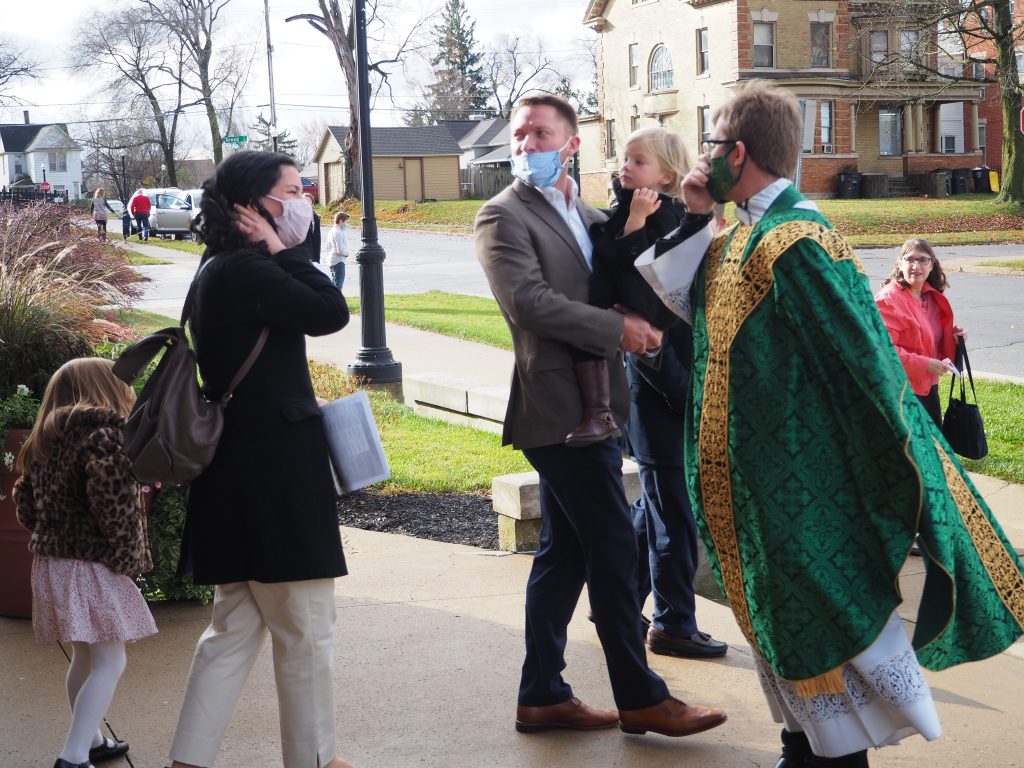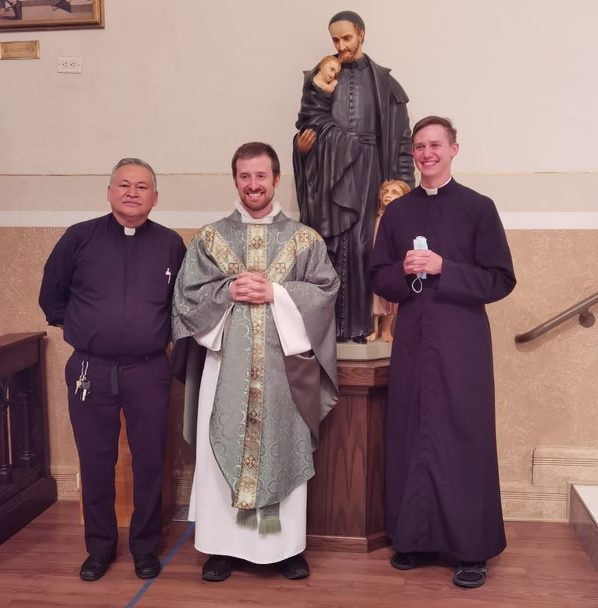November 18, 2020 // Diocese
Priests make headway at new parishes during pandemic
An African proverb says: “Smooth seas do not make skillful sailors.” While moving from parish to parish is common in priestly ministry, the changes priests encounter in adjusting to a new workplace and a different mix of people can feel overwhelming — and those who transferred this year face increased obstacles. From leaving smaller churches for larger ones, parishes with schools for those without, several priests within the Diocese of Fort Wayne-South Bend navigated the upheaval of change during an additional situation that was challenging for everyone — the statewide quarantine order.
Crossing rough waters
“There’s challenges, obviously. … You feel limited in what you can do because there are restrictions in place for people’s safety, for their health,” said Father Craig Borchard, new pastor at St. Vincent de Paul in Elkhart. He moved from St. Michael in Plymouth to Elkhart this past summer, and while the two parishes have a similar Hispanic ministry, St. Vincent is a much larger parish and school.
Once at their new parishes, getting to know the new people at the new location was a predicament. Adjusting is strange when much of the congregation is missing and parish traditions have been put on indefinite hold, Father Borchard said. “What I miss most about parish life is the day-to-day interaction with parishioners. The life of a parish flows from our faith, which we want to share with each other. When there are restrictions of gatherings, it makes it difficult to share our faith life together.”
That lack of human interaction has been their biggest struggle.
Father David Huneck went from St. Jude Parish in Fort Wayne to St. Paul of the Cross in Columbia City. At St. Jude, he was able to meet many parishioners by walking the neighborhood. In Columbia City, his congregation is spread out, so this is not an option.
He also continues as co-chaplain at Bishop Dwenger High School. Even at school, getting to know incoming freshmen and new students is similarly problematic.
I don’t know what they look like because they wear masks. And my parishioners, I don’t know what they look like. They have eyes, I know that,” he stated with a laugh.

Jennifer Barton
Father Patrick Hake, pastor of St. Peter Parish, Fort Wayne, greets parishioners after Mass last weekend. Getting to know the people in his parish, as well as how the parish itself operates, has required extra creativity of Father Hake and other pastors who were transferred to new parishes during the last nine months because of the pandemic-related suspension of Masses, necessary mask wearing and the cancellation of parish social events.
He is certainly not the only priest to face adversity with humor. Father Patrick Hake, now pastor of St. Peter Parish in Fort Wayne and co-chaplain at Bishop Luers High School, joked that it “would be helpful if parishioners all start talking in third person. ‘Father Patrick greets you; Father Patrick asks how your day is going.’”
For some priests, the pandemic marks their first time serving as pastor. As Father Huneck stated, “I don’t really know any different, so this is kind of normal, I guess. I’d moved into a parish as associate and met people there, but my first time as pastor, I’m kind of like, ‘OK, this is how it is.’”
Priests tend to make only small changes when they first arrive at a parish, and this has been true for most new pastors this year. Ready to hit the ground running, Father Hake found his efforts thwarted by the pandemic. “I have a lot of energy. I want the Church to fulfill its mission,” he said.
Not every parish had resources in place to allow priests to communicate easily with their flock. Other parishes might have outdated records or no directory, so pastors had to utilize alternate means. This included learning parishioners’ names from collection envelopes, writing bulletin letters and posting homilies online.
“I never thought that March 17, 2020, would be the last Mass celebrated publicly for nearly two months,” said Father Robert Garrow, who was transferred to St. Stanislaus Kostka in New Carlisle this year.
That was one challenge Father Garrow faced. To bridge the gap, he sent out an introductory letter to every parishioner when he arrived at St. Stanislaus. He followed up with another letter offering suggestions for parishioners to maintain their faith life at home.
He misses being able to visit the sick and homebound and worries over the “faith of the parishioners during this time. There are so many times I hear from people that watching Mass at home is not the same, their prayer life has been struggling, they feel far from God. This makes me sad, and I take these to the Lord and ask for His grace to fill us.”
A brother is born out of adversity
So, where do these pastors turn when they need help and guidance? One of the best resources is the people of the parish themselves and the parish staff. Father Hake credited parish secretary Karen Zawodni, who has been part of the parish for somewhere around 30 years. He called her “a gold mine of information,” and added that Zawodni, who is also the organist, sacristan and cantor, “keeps things flowing when I’m not sure how things ought to flow.”
Father Borchard recognized the efforts of his parish and school staff as the ones who keep things running smoothly. But even more supportive are his brother priests. He relied on his parochial vicars, Father Eloy Jimenez and Father Daniel Niezer, who have both been at the parish for a year, to share their knowledge and experience.
To implement social distancing requirements, St. Vincent added two more weekend Masses, bringing the total to eight. Fortunately, with three priests, it was not unbearable. In fact, all three priests stand outside church after Mass to greet parishioners and ease the isolation felt on both sides.
Additionally, previous pastor Father Matthew Coonan has been “an incredible help.” Father Borchard continued: “The parish was healthy when he left; it was vibrant and doing well and fulfilling its mission and living for Jesus … and it continues to do that.” Though Father Coonan is finding his way with two new parishes, he has still been a source of wisdom for Father Borchard.
Another thing that helped acclimate Father Hake to his new parish is attending meetings of the ministries that have resumed, such as the Knights of Columbus, Rosary Sodality — and, of course, the parish council. He also has a great deal of admiration, he said, for elderly parishioners who still send in their weekly envelopes, even if they have not been able to attend in person.
For those with access, he posts audio recordings of his homily on the parish’s Facebook page.
Of course, the greatest aid to priests is God. A life rooted in prayer is essential for priestly ministry, especially this year. “As a priest, I try to turn things over to God,” said Father Garrow. “I also have to remember that I am only one person, and I have a staff, a parish family to assist our parish to meet our needs. We are all working together for the glory of God and sanctification of His people.”
Ask and ye shall receive
How can those in the pews or at home assist their new shepherds? “Number one, by your prayers,” said Father Garrow. “Secondly, ask if there is anything to help with in the parish: cleaning, making phone calls, helping in other ways.” He also suggests that members contact the parish office to ensure that their information is up to date.
Father Huneck advised, “It’s always good to introduce yourself and you can even call the office and introduce yourself, then you have more time. You can schedule a meeting with the priest. I still meet with people. … If you think the priest is doing a good job, let him know.”
“Those who feel safe to invite me over, invite me over,” offered Father Hake. “There’s been about four or five families that have invited me over, so I definitely appreciate that.”
The silver lining
On the flip side, Father Borchard sees an advantage to the less-frenzied pace of parish life. “It can also kind of work in your favor in the sense that it’s not quite as busy. It’s not quite as crazy because not everything’s up and running full speed. … It’s coming at me just a little bit slower than maybe it would come at me than if I’d come here in a normal time.”
What do these priests most look forward to when the face masks finally come off? “I want to sing,” said Father Hake.
Both he and Father Huneck also hope to organize parish events in the future. Father Huneck stated, “Our parish feast day is Oct. 20, so it’s the perfect time to do an Octoberfest, so next year maybe have something like that. I think people are going to be desperate for human interaction after this.” He also plans to bring Catholic traditions such as midnight Mass and eucharistic processions to his parish to bolster its faith life. Father Hake is looking ahead to the 150th anniversary of St. Peter Parish in two years.
For now, these priests are taking their time adjusting to the new culture and anticipating the day when their congregations will be whole again. As Father Borchard put it, “Many priests will tell you, the people of God are always awesome. Any parish you go to, the people are always amazing and beautiful, which is great. … And they love their priests. They support us, we support them.”
The best news. Delivered to your inbox.
Subscribe to our mailing list today.







